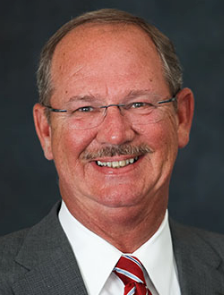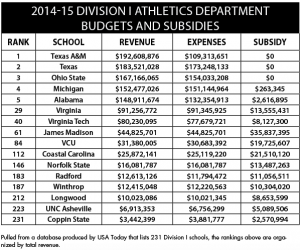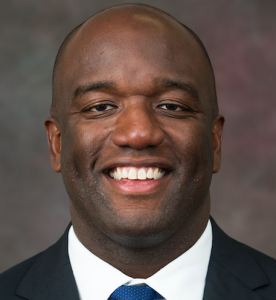LU sports does lot with a little
Published 12:55 pm Thursday, November 3, 2016
Editor’s note: As a relatively small university, Longwood does not necessarily spend as much money on its athletics program as other NCAA Division I schools. Where do its financials stand, how does it manage to compete and what is its potential for growth?
Longwood University’s athletics program joined the NCAA Division I ranks in 2008, stepping up to a new level of competition on more than one plane. Contests take place not only on fields, courts, courses and trails but also on spreadsheets, databases, charts and documents pertaining to finances.
The world of Division I involves billions of dollars and it is important to know where Longwood fits in this landscape, how it can be competitive and how it can grow moving forward.
According to a USA Today database listing the 2014-15 athletics budget information for 231 Division I schools, Longwood ranked 212th in total revenue with $10,023,086 and 211th in total expenses with $10,021,345, a $1,741 margin.
Perched at the top of the rankings in revenue is Texas A&M University with $192.6 million, an increase of $73.13 million from the previous year. An ESPN article citing an Outside the Lines analysis of NCAA data noted that the Aggies jumped to the top spot due to donations received for the renovation and expansion of Kyle Field, the home of its football program, currently No. 4 in the nation in the College Football Playoff Rankings.
The University of Texas claims the top ranking in total expenses with $173.25 million.

Kyle Kallander
Restricting the view of the Division I landscape to the state of Virginia, Longwood is ranked 11th out of 11 listed schools in both revenue and expenses. Taking the top spot is the University of Virginia, with $91.26 million in revenue and $91.35 million in expenses.
Texas A&M, Texas and Virginia all feature football teams competing at the Football Bowl Subdivision (FBS) level of Division I, putting them in a decidedly different category than Longwood.
“The revenue model is very different from the top of college athletics to everybody else,” Big South Conference Commissioner Kyle Kallander said.
Therefore, while the preceding comparisons give a big-picture contrast, it is useful to compare the Lancers to one of its Big South Conference rivals also without a football program.
Radford University matches this description and ranks 10th out of 11 among listed Virginia schools in both revenue ($12.61 million) and expenses ($11.79 million). Another Big South school, University of North Carolina- Asheville, had $6.91 million in revenue and $6.76 million in expenses.

Dr. Ray Gaskins
Returning to a statewide view, Longwood ranks 13th out of 14 Division I schools in average head coach salary, with Virginia at No. 1 with $588,898.
These comparisons lead to a key question: Can Longwood be competitive in big-time athletics with the budget it has?

Franklin Grant
Dr. Ray Gaskins, the retired Hampden-Sydney College professor who has been a prominent financial supporter of Longwood athletics, answered the question by pointing to the program’s track record.
“Actually, it has been competitive in softball, baseball,” he said. “It hasn’t been competitive in basketball lately, but we think that’s going to change this year.”
The Longwood softball team has won the Big South Championship in 2013, 2015 and 2016, it has earned three NCAA Tournament wins in the last two years and made the program’s first-ever NCAA Regional Championship appearance earlier this year in May.
The Longwood baseball team won 32 games this year, a record in the school’s Division I era. The Lancers also went 14-10 in Big South, tied for second in the conference and advanced to the Big South Tournament semifinals where they lost 5-1 to the eventual national champions, Coastal Carolina University, a team they beat earlier in the year.
“To be successful in Division I, it takes resources,” Kallander said. “But at the same time, you don’t need to necessarily be U.Va. in order to be successful in terms of the revenue if you’re smart about what you’re doing. And you see that across the country — smaller programs that are successful by being smart with their resources and hiring the right people. So, getting the right coaches is really important.”

Longwood Director of Athletics Troy Austin echoed these thoughts, using Lancers Head Softball Coach Kathy Riley as an example.
“At the end of the day, it’s a people business,” he said. “As Coach Riley has highlighted, her budget is not at the top of our conference, and there are programs she’s faced and defeated that have bigger budgets, but she’s always consistently been competitive.”
He added that the softball team’s performance is an example of the success that comes when Longwood applies a committed, focused approach to a goal.
Praising Longwood’s athletics leadership, Kallander said, “I think they’re getting good people in the right places. I think they’re being smart about what they’re doing, but they’re also identifying areas that they want to get better in and improve in.”
Given the Big South’s status as a mid-major conference as opposed to a high major, Kallander expressed admiration for the athletics directors of member schools that have the challenge of attracting quality coaches and then — as much as they can — retaining them.
“Because you know if somebody’s very successful, ultimately, they’re going to move up,” he said.
Schools, as well, have been known to move from one conference to another. Conference affiliation can play an important role in the size of an athletics budget, which can prompt the following question: Is the Big South the right fit for Longwood?
“It’s the right fit right now,” Gaskins said. “We were independent there for quite a while, and we were really lucky to get somebody as good as the Big South, so I’m just counting our blessings to be conference affiliated at this point.”

Troy Austin
Former Senior Associate Vice President for University Advancement Franklin Grant said he thinks the Big South is the exact right fit.
“When you look around and look at the schools in North Carolina, South Carolina, what other conference do we fit in?” he asked. “I’m perplexed to think of one.”
Austin affirmed Longwood is committed to the Big South.
“And I think there’s revenue that can be discovered through our program’s success, particularly with the conference initiating a new strategic plan,” he said.
The Big South summarizes its plan as follows: “The objective of the new plan is to transform the Big South Conference into the premier non-FBS conference in the Southeast. The primary areas of focus are basketball success, media exposure, academic centrality, student-athlete experience and messaging/branding.”
Longwood finds itself in lock-step with this plan as it puts a priority on its basketball program.
The athletics department does not receive any direct television revenue, which reveals room for growth, and Austin said discussions have begun regarding the possibility of televising and producing games. But as is the case with most schools, the primary opportunities for TV revenue come through and are managed by the conference with which they are affiliated.
“That’s another reason why I’m excited about our conference’s strategic plan to focus on some of the sports that TV is more attracted to,” Austin said.
Grant said he is not “over the moon” about the potential for increased returns via Big South TV revenue but added that Longwood producing teams that win can certainly enhance the potential.
“I don’t want to make that seem overly simplistic, but if you win, you’re going to be on TV,” he said.
Current returns for Longwood athletics come through other avenues including from participation in away games ($473,000), contributions ($185,296), sports camps ($140,986), ticket sales ($24,270) and other operating revenue ($128,236).
Longwood’s 86.34 percent subsidy, ranked No. 2 in the state for 2014-15, is made up of $473,653 of direct institutional support and $8.18 million in student fees.
As much as 47.8 percent of a Longwood student’s fee has gone to the athletics budget in the past, but that percentage has dropped each year since 2010-11 as the school has been able to tap into other sources of revenue, including philanthropy, sponsorships and royalties.
In the 2015 fiscal year, Longwood athletics received $417,699 in sponsorships, royalties, licensing and advertisement. Longwood’s direct contributors generated $176,771 of that total, while the Big South Conference and NCAA contributed $240,928 from their respective corporate sponsorships.
Austin said Longwood has made great strides in terms of gaining corporate sponsorship, and Gaskins has noticed.
“I think they’re doing pretty well considering their size and the Big South,” he said.
Longwood’s biggest corporate sponsors are Benchmark Community Bank and Hampton Inn.
“We don’t formally survey it, but our (corporate sponsorship) numbers compare well with peer institutions — really well, actually — and I don’t even mean just in the Big South,” Austin said. “I mean other Division I schools that do not sponsor football.”
Grant noted that more major chains are coming into the area.
“The more you have, the more competition, and competition breeds success sometimes,” he said. “You have to be there, and you have to welcome those people, and you have to stay on top of those things.”
Gaskins’ individual financial contributions to Longwood have essentially been equal to those he has made to Virginia Tech, which has one of the most successful Division I programs in the state. He has been diligent to pass along ideas to Longwood when he learns a new initiative that the Hokies have undertaken.
“For example, the latest item has been to put the student-athletes who are on scholarship on baseball cards and give them to the sponsor of the scholarship that they’re on,” Gaskins said.
Through this, both the scholarship sponsor and the recipient know of each other personally.
“I’ve had one potential scholarship donor tell me that unless the recipients knew that he was the donor, he wasn’t really interested in getting involved,” Gaskins said.
He praised a Longwood practice of holding a dinner in which donors get to meet the students benefiting from their donation.
“I’ll get a letter from the recipient at Virginia Tech, thanking me for the scholarship, but we don’t get together in person, because there’s too many of them, whereas Longwood’s a smaller venue, and you can do it.”





